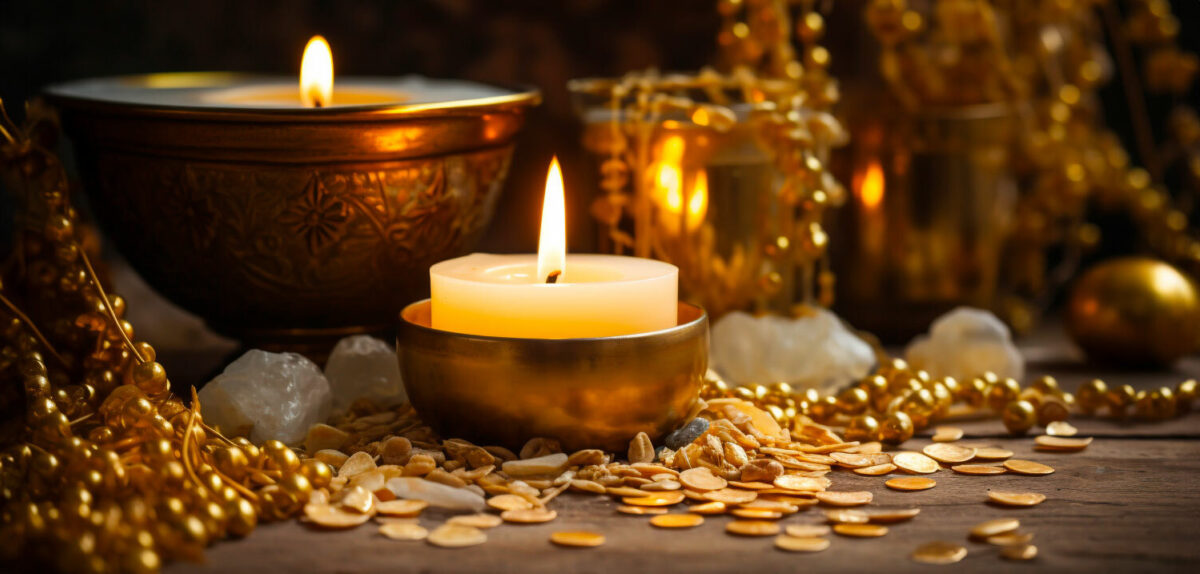
Building a Gratitude Altar: Rituals and Practices for Deepening Thankfulness
The act of giving thanks has been a cornerstone of spiritual practices across cultures for centuries. One profound way to express gratitude is through the creation of a gratitude altar—a sacred space where you can reflect on your blessings, offer thanks, and deepen your connection to the divine or the universe. This guide will take you through the history of gratitude altars, how different spiritual traditions honor gratitude, and offer practical steps and rituals for creating your own altar at home.
The History of Gratitude Altars
Altars have been a focal point of spiritual life for millennia, serving as a space where people could offer thanks, pray, and connect with divine energies. Throughout history, gratitude altars have played a key role in expressing thankfulness for blessings, health, and prosperity.
In ancient Egypt, altars were present in both temples and homes, where people made offerings to gods like Ra, Isis, and Osiris. These offerings, which included food, drink, incense, and flowers, symbolized gratitude for life’s blessings and served to strengthen the relationship between humans and the gods. Egyptians believed that honoring their deities through altars would bring protection and abundance.
The Greeks and Romans also used altars to honor their gods. In Greece, altars dedicated to deities like Zeus, Athena, and Demeter were central to public and private life. Offerings were placed on altars during festivals and daily prayers as a way to express gratitude for a bountiful harvest, good health, and military victories. Similarly, Romans maintained household altars - called lares - where they offered thanks to protect the family and ensure prosperity.
In Native American cultures, altars often took the form of natural elements like stones, feathers, and plants. These simple yet sacred spaces were used in ceremonies to honor the interconnectedness of life and give thanks to the earth, water, and animals. Native American altars were deeply tied to nature, reinforcing the belief that expressing gratitude helps maintain harmony with the natural world.
Through these historical examples, we see how gratitude altars have evolved as places of connection between the human and divine realms, grounding us in the practice of giving thanks for life’s blessings.
Gratitude in Different Spiritual Traditions
Gratitude remains a central component in many spiritual practices today, expressed through rituals, ceremonies, and the use of altars. Here’s how gratitude is honored in different spiritual traditions:
Native American Traditions
In Native American spiritual practices, gratitude is considered essential to maintaining harmony with nature and the spirit world. Ceremonies often incorporate gratitude altars made of natural materials, like stones and feathers, where offerings are made to thank the earth, sky, water, and animals. These altars serve as a reminder of the interconnectedness of life and the importance of honoring the natural world for its sustenance.
African Traditions
In Yoruba and other African spiritual traditions, gratitude is expressed communally, often with altars dedicated to deities and ancestors. Offerings of food, drink, and flowers are placed on altars as a way to thank the Orishas for blessings such as health, fertility, and prosperity. Gratitude rituals in these traditions focus on personal blessings as well as maintaining strong connections with ancestors and ensuring communal well-being.
Christian Practices
In Christianity, gratitude is central to worship and prayer. Churches often have altars where believers offer prayers of thanks and partake in sacraments such as communion. In Christian households, gratitude is expressed through prayers before meals and during holidays like Thanksgiving, which celebrates the blessings of the harvest and family. Personal altars may be used for daily prayers to thank God for his guidance and blessings.
Pagan and Wiccan Traditions
In Pagan and Wiccan practices, gratitude is expressed through rituals that honor the cycles of nature. Seasonal festivals like Lammas and Samhain are times to give thanks for the earth’s abundance, with offerings of grain, fruits, and flowers placed on altars dedicated to deities and the elements. Wiccans believe that showing gratitude helps maintain balance with the natural world, making offerings an integral part of their spiritual practice.
Hindu and Buddhist Traditions
In Hinduism and Buddhism, gratitude is a part of everyday life. Hindus often have altars in their homes where they perform puja, offering food, flowers, and incense to deities such as Lakshmi (goddess of prosperity) as a way of giving thanks for the blessings received. In Buddhism, gratitude is cultivated through mindfulness and meditation. Altars with statues of the Buddha, candles, and offerings are used as spaces to reflect on the present moment and express thankfulness for life’s impermanence and blessings.

Keeping an altar devoted to being thankful is a great way to remember to appreciate what you have, and to give thanks regularly.
Creating Your Gratitude Altar
Building a gratitude altar is a deeply personal practice, allowing you to create a sacred space where you can regularly reflect on and express thanks for the blessings in your life. Here’s how you can create a simple yet meaningful gratitude altar:
- Choose a Space: Select a quiet, peaceful area in your home where you can set up your altar. This could be a small table, a shelf, or even a windowsill.
- Cleanse the Space: Use Altar Oil to anoint the area and clear away any stagnant energy, preparing the space for your rituals.
- Add Key Elements: Place a gold candle on the altar to symbolize abundance and success. Add a clear quartz crystal to amplify positive energy and focus your intentions. Set a bowl on the altar for offerings, such as food, honey, or flowers, and include an incense holder for burning frankincense incense, which is often used for purification and uplifting energy.
- Personalize It: Add items that hold personal significance to you. This could include photographs, stones, or talismans. You might also want to place white camellia flowers, which are traditionally associated with gratitude, on the altar to enhance the energy of thankfulness.
Once your altar is set up, it becomes a dedicated space for practicing gratitude. You can return to it whenever you wish to reflect, offer thanks, or perform rituals.
Rituals for Expressing Gratitude
Below are three simple but powerful gratitude rituals you can perform at your altar. These rituals use items that help enhance your spiritual connection and express your gratitude.
A Candlelight Gratitude Ritual
This daily ritual uses the light of candles to focus your intentions and express thanks to the Divine or the universe for the blessings you receive. Prepare the following items:
- 1 Gold Candle (symbolizing success and abundance)
- 2 White Candles (representing purity and gratitude)
- Frankincense Incense (for purification)
- Frankincense Oil (for blessing the candles)
Place the gold candle in the center of your altar, with the two white candles on either side. Anoint the candles with frankincense oil to bless them. Light the frankincense incense and allow the scent to fill the space. As you light each candle, reflect on what you are grateful for—whether it’s your health, relationships, or opportunities. You may choose to say aloud, “I give thanks for the blessings in my life.”
Sit quietly, focusing on the warm glow of the candles and allowing gratitude to fill your heart. When ready, snuff out the candles to end the ritual.
A Full Moon Gratitude Offering
This ritual aligns with the energy of the full moon, amplifying your gratitude and drawing in continued blessings. These items are essential for the ritual:
- 1 Gold Candle
- Calendula Flowers (representing gratitude)
- A bowl for offerings
- Honey (symbolizing sweetness and abundance)
Set the gold candle on your altar and place the white calendula flowers around it. Pour a small amount of honey into a bowl as an offering to represent the sweetness of life’s blessings. Light the candle, and as it burns, speak aloud your thanks for the abundance in your life—such as family, health, and prosperity.
As the full moon’s energy amplifies your gratitude, visualize your blessings expanding and multiplying. When finished, leave the honey offering on your altar overnight and snuff the candle to close the ritual.
Fire of Gratitude and Release
This ritual is perfect for those seeking to express gratitude while releasing old energy, making space for new blessings to come into your life. You will need the following for this ritual:
- A piece of paper and pen
- Jasmine Oil (for anointing the paper)
- A fireproof bowl
- A lighter or matches
Begin by writing down everything you are grateful for on a piece of paper. Once completed, anoint the paper with jasmine oil, which symbolizes peace and clarity. Take the paper outside with a fireproof bowl. Use the lighter to ignite the paper, placing it in the bowl as it burns. As the paper turns to ash, imagine the smoke carrying your gratitude into the universe.
You may say, “I give thanks for all that I have and release what no longer serves me.” Scatter the ashes in a natural space to complete the ritual, symbolizing your gratitude returning to the earth.
Gratitude Rituals Around the Thanksgiving Season
As autumn deepens and the year begins its slow closing, many people feel naturally drawn toward practices of reflection and thanks. The Thanksgiving season, with its themes of harvest, home, and shared blessings, offers a powerful, energetic window for gratitude work. While the holiday itself is modern, the impulse to gather in community and honor abundance echoes ancient traditions from around the world.
During this time, gratitude rituals often carry an extra sense of warmth and intention. Some practitioners choose to offer quiet prayers of thanks to acknowledge the support, protection, and guidance they’ve received throughout the year. Others lean into harvest-centered gratitude rituals, using the season’s grounding energy to honor the blessings that have ripened in their lives. These practices can be especially meaningful when paired with altar work, candlelight, or offerings of food and flowers.
Whether celebrated alone or with loved ones, Thanksgiving becomes an invitation to slow down, breathe deeply, and reconnect with what truly sustains you. By approaching the holiday as a spiritual moment rather than a single day, you create a space where gratitude can take root in a lasting way.
Bringing Gratitude into Everyday Life
While these rituals provide focused opportunities to express gratitude, cultivating thankfulness can be an everyday practice. Consider keeping a gratitude journal, practicing small acts of kindness, or simply saying “thank you” more often. By shifting your mindset from “I have to” to “I get to,” you’ll find more joy in life’s daily tasks and opportunities.
The Power of Gratitude
Creating a gratitude altar and incorporating rituals of thankfulness into your routine can profoundly impact your spiritual practice. These simple acts help you focus on the blessings in your life, opening your heart to receive even more abundance. Whether you engage in daily candlelight rituals, seasonal offerings, or transformative ceremonies, gratitude can serve as a powerful tool to connect with the divine and maintain a flow of positivity in your life.
By making gratitude a regular part of your spiritual routine, you create a continuous cycle of receiving and giving, deepening your connection with yourself, the universe, and those around you.













